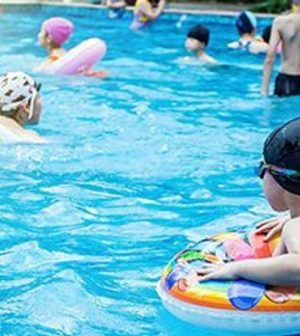- Navigating Your Midlife Crisis: Embracing New Possibilities
- City Raccoons Showing Signs of Domestication
- Mapping the Exposome: Science Broadens Focus to Environmental Disease Triggers
- One Week Less on Social Media Linked to Better Mental Health
- Your Brain Changes in Stages as You Age, Study Finds
- Some Suicide Victims Show No Typical Warning Signs, Study Finds
- ByHeart Formula Faces Lawsuits After Babies Sickened With Botulism
- Switch to Vegan Diet Could Cut Your Greenhouse Gas Emissions in Half
- Regular Bedtime Does Wonders for Blood Pressure
- Dining Alone Could Mean Worse Nutrition for Seniors
Child Drownings in U.S. Pools, Spas Are on the Rise

Pool and spa drowning deaths among U.S. children are spiking upwards, and restrictions related to the COVID pandemic may also mean that fewer kids are getting the swimming lessons that might keep them safe, the Consumer Product Safety Commission warns.
On average, there were about 400 reported pool/spa drowning deaths among children younger than age 15 each year from 2016 through 2018, according to new CPSC data.
Three-quarters of those deaths involved children younger than 5, and 83% of those occurred in residential pools.
Child drownings remain the leading cause of unintentional death among U.S. children ages 1 to 4, according to the CPSC.
“As we enter the summer months, parents and caregivers must be mindful of the pandemic’s impact on their children’s swimming ability and water safety skills,” said Robert Adler, CPSC acting chair.
“CPSC’s latest report confirms that most child drownings involve children under the age of 5, whose limited experience around the water due to recent social distancing restrictions could put them at greater risk of drowning,” he added in a CPSC news release.
“With fewer children attending swimming lessons during the past year, it is critical to refresh these and other lifesaving skills, while practicing increased vigilance both anywhere children are swimming and during non-swim times as well,” Adler said.
From 2018 to 2020, nearly 8 in 10 nonfatal drowning injuries also occurred among children younger than 5.
The data show that the number of pool/spa-related, hospital emergency department-treated, nonfatal drowning injuries fell from 2019 to 2020, but the decline is not statistically significant, according to the CPSC.
The lower number of drownings is likely due to limitations on summer activities — including group or public swimming — during the COVID-19 pandemic, the agency said.
It offered the following water safety tips.
- Never leave a child unattended in or near water. The designated adult water watcher should not read, text, use a phone or otherwise be distracted while watching children. This advice includes situations involving bathtubs, buckets, decorative ponds and fountains.
- If you own a pool or spa, install layers of barriers to prevent an unsupervised child from getting to the water. These measures can include door alarms, pool covers and self-closing, self-latching devices on doors that access the pool and on gates of four-sided fences.
- Learn how to perform CPR on children and adults.
- Learn how to swim and teach your child how to swim.
- Keep children away from pool drains, pipes and other openings to avoid entrapments. Your pool or spa should have drain covers that comply with federal safety standards. If you’re not sure, ask your pool service provider about safer drain covers.
More information
The American Red Cross has more on water safety.
SOURCE: Consumer Product Safety Commission, news release, June 8, 2021
Source: HealthDay
Copyright © 2025 HealthDay. All rights reserved.










